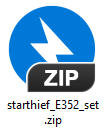(SynthTech E352 & E370, IME Piston Honda mk3, 4ms Spherical Wavetable Navigator, Bitwig 3.3+, and possibly others I’ve missed)
Since I just went through my set of wavetable banks for the E352, culling it down to 26 favorites and organizing it a bit better, I thought maybe I should make (most of) them available here.
What is included:
- 6 banks of definitely original content.
- 5 banks converted from other formats, which other people converted/sampled from older hardware (PPG, Fairlight, and Alpha Juno.)
- 6 “maybe” banks — I don’t recall whether I created them myself or converted from noncommercial sources in other formats. (Blame my poor organization and the necessity of using 8.3 format filenames for the E352/E370.)
- Names and descriptions of a handful of XFer Serum banks and one NI Massive bank that I converted for my own use. However, I don’t feel comfortable actually redistributing them, so please don’t ask. I feel that sampling synths from the 70s and 80s into wavetables is a very light gray area, but converting wavetable data included as factory presets in software instruments released in 2007 and 2014 is extremely murky.
- Names of a couple of other peoples’ banks I really like from WaveEdit Online.
- A guide to converting Serum wavetables to WaveEdit, which is also below. Serum’s built-in wavetable editor has features WaveEdit lacks, including the ability to import from other formats, and it can also be a powerful way to create original new banks.
I have particular tastes and opinions where it comes to wavetables. For instance, I mostly prefer banks that are typically meant to be animated either with a smooth LFO to provide motion (for example, PWM) or with a decay envelope one-dimensionally across a wide range of the bank. While some banks that consist of many different unrelated waveforms can be useful — where the typical usage is to find a “sweet spot” and modulate the position only very slightly — there is little need for more than a few of these, and the E352/E370 have three quite good ones built in. I also don’t tend to use two-dimensional morphing on the E352, preferring to instead add wavefolding, FM, PM or Cloud mode.
Converting Serum wavetables to WaveEdit E352/E370 format
In your VST host:
0: Set tempo to 120 BPM if it’s not already.
In Serum:
1: Start with an Init patch.
2: Load the wavetable of your choice into Osc A (or import or create one in the editor). Set up morphing in the editor if necessary.
3: Set LFO #1 to 1/4 note, in Env mode, and load the Basic/Saw Up preset.
4: Assign LFO 1 to WT Pos on Osc A.
5: Under the Menu, choose “Resample to Osc B.”
6: Enable Osc B and go into its wavetable editor.
7: Under Export, pick “Export All as 16-Bit” and save a file.
In WaveEdit:
8: Under Import, choose the file you just saved.
9: Set Offset to 0, Snap to Power of 2 on, and Zoom to 8.0000.
10: Click Import. Voila!
The theory behind this method
Serum wavetables can have some arbitrary number of waves per bank — maybe 3, maybe 17, maybe 59. But “Resample to Osc B” always writes one bar’s worth of material into exactly 256 samples in Osc B’s bank. By choosing 1/4 note at 120bpm morph time, we pack our relevant wavetable data into the first 64 samples instead (the last 3/4 of Osc B is uesless).
From there, zooming in at a factor of 8x inside WaveEdit translates that from 2048×64 to 256×64 samples, and also ignores the useless part that we exported out of Serum Osc B. Very tidy!

